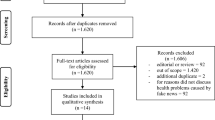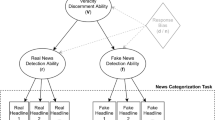Abstract
A mathematical model for assessing the informational impact on the electorate in social media during election campaigns is developed. It is based on the well-known mathematical models of information warfare in a structured society and differs from them by taking into account the stochastic nature of the intensity of information dissemination from external sources. The final model is reduced to a system of stochastic differential equations, understood in the sense of Ito. The estimate of the number of adherents and preadherents who favor a candidate during the election campaign is given by the sample mean, which is calculated by the probability density function determined from the solution of the Fokker–Planck–Kolmogorov equation. The Fokker–Planck–Kolmogorov (FPK) equation is solved according to the proposed numerical scheme based on the projection formulation of the Galerkin method. The simulation results for the test problem are presented.



Similar content being viewed by others
REFERENCES
D. P. Gavra, “Public opinion and power: Modes and mechanisms of interaction,” Zh. Sotsiol. Sots. Antropol. (J. Sociol. Soc. Anthropol.) 1 (4), 53–77 (1998).
G. B. Pronchev and V. I. Muravyov, “Social networks as a factor in Russia’s transition to innovative development,” Sotsiologiya, No. 3, 36–56 (2011).
S. G. Davydov, “Open opinion project as a social experiment: interactions with mass media and social media,” Sotsiol. Zh. (Sociol. J.), No. 1, 118–138 (2012).
A. P. Petrov, A. I. Maslov, and N. A. Tsaplin, “Modeling position selection by individuals during information warfare in society,” Math. Models Comput. Simul. 8 (4), 401–408 (2016). https://doi.org/10.1134/S2070048216040141
A. P. Mikhailov, A. P. Petrov, G. B. Pronchev, and O. G. Proncheva, “Modeling a decrease in public attention to a past one-time political event,” Dokl. Math. 97 (3), 247–249 (2018). https://doi.org/10.1134/S1064562418030158
A. P. Petrov and O. G. Proncheva, “Modeling position selection by individuals during informational warfare with a two-component agenda,” Math. Models Comput. Simul. 12 (2), 154–163 (2020).
A. A. Samarskii and A. P. Mikhailov, Principles of Mathematical Modelling: Ideas, Methods, Examples (Fizmatlit, Moscow, 2001; CRC Press, London, 2002). https://doi.org/10.1201/9781482288131.
A. P. Mikhailov, A. P. Petrov, N. A. Marevtseva, and I. V. Tretiakova, “Development of a model of information dissemination in society,” Math. Models Comput. Simul. 6 (5), 535–541 (2014). https://doi.org/10.1134/S2070048214050093
C. W. Gardiner, Handbook of Stochastic Methods for Physics, Chemistry, and the Natural Sciences (Springer, New York, 1983; Mir, Moscow, 1986).
D. F. Kuznetsov, Numerical Modelling of Stochastic Differential Equations and Stochastic Integrals (Nauka, St. Petersburg, 1999) [in Russian].
D. F. Kuznetsov, Some problems in the theory of the numerical solution of Ito stochastic differential equations (monograph), Differ. Uravn. Protsessy Upr., No. 1, 66–367 (1998). https://doi.org/10.18720/SPBPU/2/z17-6
I. I. Gikhman and A. V. Skorokhod, Introduction to Theory of Random Processes (Nauka, Moscow, 1977) [in Russian].
H. Federer, Geometric Measure Theory (Springer, New York, 1969; Nauka, Moscow, 1987).
V. I. Tikhonov and M. A. Mironov, Markov Processes (Sov. Radio, Moscow, 1977) [in Russian].
I. S. Polyanskii, N. S. Arkhipov, and S. Yu. Misyurin, “On solving the optimal control problem,” Autom. R-emote Control 80 (1), 66–80 (2019). https://doi.org/10.1134/S0005117919010065
I. S. Poljanskii, “Barycentric method in the optimal control problem for the shape of the reflecting surface of a mirror antenna,” Mat. Model. 29 (11), 140–150 (2017).
P. S. Aleksandrov and B. A. Pasynkov, Introduction to Dimension Theory: An Introduction to the Theory of Topological Spaces and the General Theory of Dimension (Nauka, Moscow, 1973) [in Russian].
I. S. Poljanskii, D. E. Stepanov, D. K. Ketukh, and V. A. Shevchenko, “Electrodynamic analysis of mirror antennas in the approximation of the barycentric method,” Fiz. Volnovykh Protsessov Radiotekh. Sist. 23 (4), 36–47 (2020). https://doi.org/10.18469/1810-3189.2020.23.4.36-47
J. R. Dormand and P. J. Prince, “A family of embedded Runge–Kutta formulae,” J. Comput. Appl. Math. 6 (1), 19–26 (1980). https://doi.org/10.1016/0771-050X(80)90013-3
A. Genz and R. Cools, “An adaptive numerical cubature algorithm for simplices,” ACM Trans. Math. Software 29 (3), 297–308 (2003).https://doi.org/10.1145/838250.838254
Z. Chen, “Bayesian filtering: from Kalman filters to particle filters, and beyond,” Stat.: J. Theor. Appl. Stat. 182 (1), 1–69 (2003).
Author information
Authors and Affiliations
Corresponding author
Ethics declarations
The authors declare that they have no conflicts of interest.
Rights and permissions
About this article
Cite this article
Poljanskij, I.S., Loginov, K.O., Ilyin, N.I. et al. Mathematical Model for Assessing the Information Impact on the Electorate in Social Media during Election Campaigns. Math Models Comput Simul 14, 590–598 (2022). https://doi.org/10.1134/S207004822204007X
Received:
Revised:
Accepted:
Published:
Issue Date:
DOI: https://doi.org/10.1134/S207004822204007X




